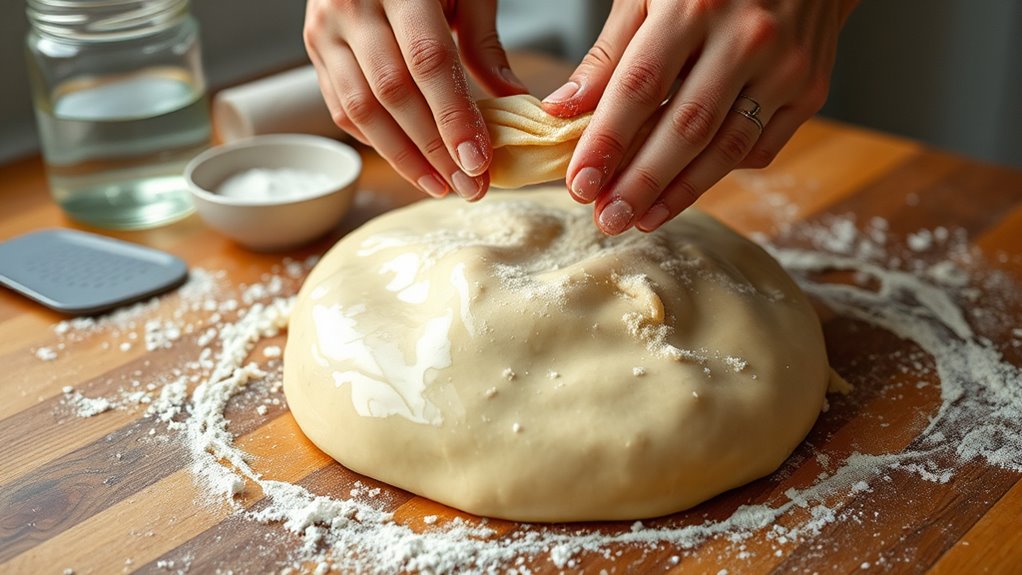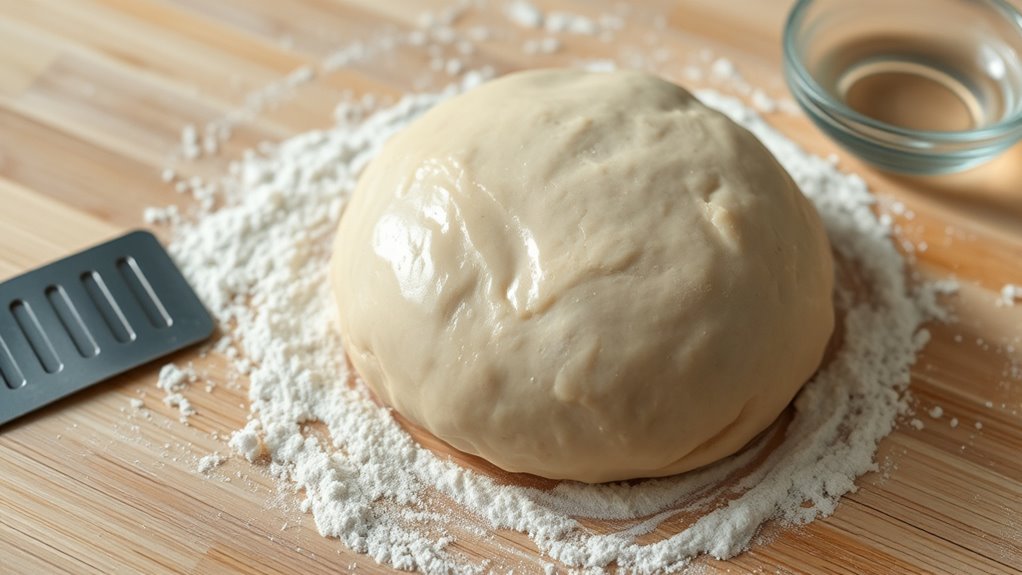To manage sticky dough, start by lightly dusting your work surface and hands with flour to prevent sticking, but avoid over-flouring to keep the dough’s texture intact. Adjust hydration by adding small amounts of water or flour gradually until the dough feels manageable. Use gentle kneading techniques and let the dough rest to allow gluten and flour absorption, making it easier to handle. Stick with these tips, and you’ll soon master smoother, less sticky dough.
Key Takeaways
- Gradually add small amounts of flour during kneading to control stickiness without over-drying the dough.
- Adjust hydration levels based on flour type and environmental humidity to maintain optimal dough consistency.
- Use gentle folding and pressing techniques to develop gluten without overworking, reducing stickiness.
- Rest the dough for a few minutes to allow flour hydration and gluten relaxation, making it easier to handle.
- Lightly flour work surfaces and hands to prevent sticking while handling dough, avoiding excessive flour addition.

Dealing with sticky dough can be frustrating, but with a few simple tricks, you can transform it into manageable, easy-to-handle dough. One of the most effective ways is to refine your kneading techniques. When dough is overly sticky, you might be overworking it or adding too much water initially. Instead, try kneading gently and gradually incorporating small amounts of flour as you go. Use a bench scraper or your hands to fold and press the dough, which helps develop gluten without making it overly sticky. Proper kneading creates structure, so the dough becomes more elastic and easier to handle. If the dough remains sticky despite these efforts, it might be time to think about alternative flours. Different types of flour absorb water differently; for example, whole wheat or rye flours tend to produce stickier dough than bread or all-purpose flour. When working with alternative flours, start with a slightly lower hydration level and gradually add more liquid if needed. This way, you prevent the dough from becoming too sticky right from the beginning. Keep in mind that some flours, like almond or coconut flour, behave differently and may require additional adjustments, such as more binding agents or less liquid. Experimenting with these can help you find the right balance for your specific recipe.
Additionally, hydration plays a vital role in dough stickiness. If your dough is too wet, it will cling to your hands and work surface. To fix this, sprinkle in small amounts of flour during kneading, rather than adding large quantities all at once. This method helps control the dough’s consistency without making it dry or tough. Also, consider the environment; humid conditions can make dough stickier. In such cases, a little extra flour can compensate for moisture in the air. When handling sticky dough, don’t be tempted to add excessive flour, as this can alter the texture and final outcome of your baked goods. Instead, lightly flour your work surface and hands, and use a gentle touch. Resting the dough for a few minutes can also help, as it allows the flour to fully hydrate and the gluten to relax, making the dough less sticky and easier to work with. Being aware of gluten development can also help you optimize your kneading process and improve dough texture.
Frequently Asked Questions
How Can I Prevent My Dough From Sticking to the Surface?
To prevent your dough from sticking to the surface, start by dusting the area generously with flour before placing your dough down. You can also lightly oil the surface or your hands to create a barrier. As you work, keep adding small amounts of flour if the dough feels sticky, but avoid over-flouring to maintain the dough’s texture. These methods help keep your dough manageable and prevent sticking.
What Is the Ideal Storage Method for Sticky Dough?
You should store your sticky dough in an airtight container to prevent it from drying out and absorbing odors. Refrigeration storage is ideal, as it slows fermentation and maintains freshness. Before sealing, lightly coat the dough with oil or flour to prevent sticking. Make sure the container is snugly closed and label it with the date. This method keeps your dough fresh and easy to handle when you’re ready to use it.
Can Adding More Flour Improve Sticky Dough Consistency?
Adding more flour can help, but it’s a delicate dance. It absorbs excess moisture, making the dough less sticky, and supports gluten development for better structure. However, too much flour can lead to a tough, dense texture and hinder proper hydration. To find the sweet spot, sprinkle gradually, knead gently, and monitor how the dough responds. This way, you balance absorption and elasticity for ideal consistency.
How Do I Adjust Hydration Levels for Different Flours?
To adjust hydration levels for different flours, you need to account for each flour’s absorption rate. Start by adding less water for flours with high absorption and gradually increase it if needed. Use hydration adjustment by testing small batches to find the perfect balance. Remember, whole grain flours absorb more water than white flour, so tweak your recipe accordingly to achieve ideal dough consistency.
Are There Specific Tools Recommended for Handling Sticky Dough?
You’ll want to keep your tools close when handling sticky dough—don’t let it slip away. A sturdy dough scraper is your secret weapon for folding and shaping, while a silicone spatula gently lifts and folds without sticking. These tools give you control and confidence, turning chaos into craft. With them in hand, you feel more connected, more in command—ready to conquer even the stickiest dough effortlessly.
Conclusion
Now that you know how to tame sticky dough, you can appreciate its wild, unpredictable nature. Like a playful puppy, it’s stubborn yet rewarding when handled with care. Embrace the challenge, knowing each stretch and fold brings mastery and delicious results. With patience and the right techniques, what once seemed unruly becomes a silky, manageable partner in your baking adventures—proof that sometimes, the messiest dough makes the best bread.









